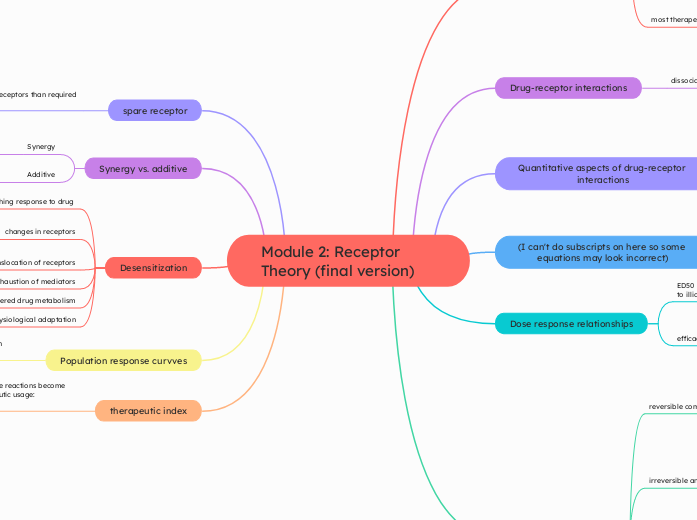Module 2: Receptor Theory (final version)
Drug-receptor binding
antagonists
NO efficacy
affinity
agonists
affinity
efficacy
most therapeutic drugs = reversible rxn
dissociation rate constant = k-1
association rate contant = k+1
Drug-receptor interactions
dissociation constant = KD
[drug] required to occupy 50% of receptors @ equilibrium
higher KD = lower affinity, vice versa (inverse relationship)
Quantitative aspects of drug-receptor interactions
law of mass action = k+1[A][R] = k-1[AR]
rate of rxn is proportional to the product of the [reactants]
association rate = dissociation rate
1st derivation: [A][R]/[AR] = k-1/k+1 = KD
ratio of occupied receptors to unbound receptor and drug equals the ratio of dissociation and association rate constants which = KD
2nd derivation (Hill-Langmuir): pA = [AR]/[Rtot} = [A]/KD+[A]
calculates fraction of drug occupied by receptors
(I can't do subscripts on here so some equations may look incorrect)
Dose response relationships
ED50 = 50% effective dose (dose of drug required to illicit 50% maximal biological response
ED50 = measure of potency
efficacy vs. potency
potency: the amount of drug required to achieve specific level of response
efficacy: measure of the maximal effect of drug @ saturating concentrations
Receptor antagonism
reversible competitive antagonist
Hill-Langmuir applies
decreases potency of agonist drug, decrease ED50
most antagonists
irreversible antagonist
perma prevents receptor from ever binding an agonist
reduce potency of agonist drug
tend to be toxins
Partial agonists
drugs that may bind but may not cause optimal conformational changes in the receptor and thus will provoke some response but not maximum possible response (cannot achieve maximal efficacy)
inverse agonists
drug that binds to constitutively active receptor and reduces constitutive activity, "negatvie efficacy"
non-competitive antagonism
allosteric antagonism
pharmacokinetic antoagonism
signaling blockade
physiological antagonism
chemical antagonism
spare receptor
cells/tissues express more receptors than required for max response
not very understood why this is, but large numbers of spare receptors = relatively modest amounts of ligands have a far greater chance of inducing max response
Synergy vs. additive
Synergy
overall effect is greater than sum of individual effects
Additive
overaell effect is direct sum of individual drug effects
Desensitization
gradual diminishing response to drug
changes in receptors
altered conformation
uncoupling of associated signaling molecules
translocation of receptors
exhaustion of mediators
altered drug metabolism
physiological adaptation
Population response curvves
ED50 = dose that produces the desired effect in 50% of treated population
therapeutic index
the point of dosage that adverse reactions become too great to support its therapeutic usage: LD50/ED50
the higher the value, the safer the drug (LD50 and ED50 far from each other)
